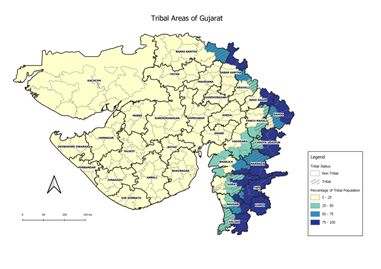
Gujarat is home to 604 lakh people of whom 89 lakh or 15% are Scheduled Tribes (Census of India, 2011). These tribal communities mainly reside in the eastern districts of the state bordering the tribal districts in southern Rajasthan, western Madhya Pradesh, and northern Maharashtra.

The tribal districts have a high sex ratio and are socially more egalitarian than the ‘mainstream’ societies. They are also endowed with many natural resources such as forests, high rainfall, and numerous rivers. Lack of sustainable livelihood, however, has led to high poverty levels in these districts.


Many irrigation policies such as those favouring large irrigation projects have not been able to give benefits to these areas. These areas are the location of dams, and cause displacement of people and livelihoods for the local tribal population, although the benefits of these dams are availed by populations living away, mostly in non-tribal areas (see table 3 and figure 1).


A state-level workshop was organised by AKRSP(I) in Gujarat to discuss issues, challenges, and solutions related to water management in the tribal areas of Gujarat. The workshop comprised group discussions & presentations, panel discussions, and field visits. The topics for group discussion were watershed, participatory irrigation management (PIM), lift irrigation including solar energy utilisation and drip irrigation, drinking water, and climate change. The discussions were followed by presentations by each group. In addition, there were panel discussions on 'water budgeting' and 'role of panchayat in water resource development in tribal areas'. The participants were also taken on an exposure field visit to Pingot Dam to understand the working of PIM.


Recommendations from the workshop
- Tribal areas have specific contextual issues such as small landholdings and hilly undulating terrain. Hence, schemes, policies and programmes should be designed to reflect the local requirements and aspirations. Schemes that are applicable and successful in large fertile plains do not perform as well in the tribal areas. For example, in Gujarat, subsidy in drip irrigation is calculated by unit cost per hectare. However, landholdings in tribal areas are much smaller (approximately 0.2 ha) and fragmented. So, there should be an appropriate mechanism in the policy to reflect this.
- Gram Sabha and Panchayat should be capacitated and empowered to implement projects more effectively, especially in the light of acts such as PESA and LARR, which empower them to exercise their rights more effectively.
- Every panchayat should have a water budget. So, support and guidance should be provided in this regard by experienced organisations. Also, water meters should be installed that would help not only in reducing electricity bills but will also monitor regular use of water and reduce water consumption at the same time.
- There are many areas in which civil society has worked and has successful and ready models which can be used by the government agencies for more efficient implementation of schemes. Civil society has managed to gain expertise in planning, technical guidance, operations, training, etc. which can be used.
- Watershed programmes have generated many benefits and there is a need to revive the projects and take them up more vigorously.
- Programmes like watershed development and participatory irrigation management (PIM) are highly successful in tribal areas and need to be scaled up, especially in tribal areas that have existing canal connectivity. Special benefits should be given to farmers who engage in PIM.
- Energy requirements for lifting water are also a key concern for irrigation. Presently, electricity, diesel, and solar energy are used in tribal areas of Gujarat in different proportions and as per farmers’ capabilities. In relation to the above, the following points were highlighted in the workshop -
- There should be a slab rate for electricity charges, wherein charges are calculated on the basis of farm size. Slab rate should be subsidized based on the landholdings of the farmer implying small and marginal farmers should be entitled to higher subsidies.
- Subsidizing Lift Irrigation Societies (LIS) is more economical than individual subsidies given by the government. LIS uses much less power per capita compared to individual consumers and also monitors total water consumption leading to a reduction in sustainable use of energy and water.
- In the event of extreme and unpredictable weather conditions, there is an urgent need to bring climate change perspective into policies related to natural resource management. Solar-based irrigation in tribal areas which reduces carbon emissions should be promoted strongly as electricity availability in tribal areas is difficult and diesel increases the cost of production for tribal farmers making agriculture unprofitable.

Way forward
Gujarat is one of the most developed states in the country. Yet, its tribal population lags behind. The four key tribal districts of Gujarat are Narmada, Tapi, Dahod, and Dangs. Among these, Dahod and Narmada are aspirational districts and Dangs is being planned to be developed as a 100% organic farming district of the state. Programmes subsidizing micro-irrigation and solar irrigation have also been implemented in these districts. As such the state has been devising strategies for the benefit of its tribal communities, what is required now is close monitoring of these programmes so that they reach their desired target.
This article is based on the State-level Workshop for Gujarat titled “Best Practices, Impact, Challenges and Opportunities in Water Resource Development & Management in Tribal Areas”. The Workshop was held on December 13 and 14, 2019 at Tribal Livelihood Resource Centre, AKRSP(I) Campus, Netrang, Bharuch. It was funded by the Axis Bank Foundation and organised by Aga Khan Rural Support Programme (India).
/articles/tribals-await-effective-implementation-policies